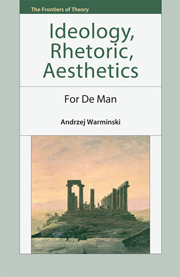Book contents
- Frontmatter
- Contents
- Series Editor's Preface
- Author's Preface
- Acknowledgements
- List of Abbreviations
- PART I Aesthetic Ideology
- 1 Allegories of Reference: An Introduction to Aesthetic Ideology
- 2 “As the Poets Do It”: On the Material Sublime
- 3 Returns of the Sublime: Positing and Performative in Kant, Fichte, and Schiller
- 4 Lightstruck: “Hegel on the Sublime”
- PART II Hegel/Marx
- PART III Heidegger/Derrida
- Appendix 1 A Question of an Other Order: Deflections of the Straight Man
- Appendix 2 Response to Frances Ferguson
- Index
4 - Lightstruck: “Hegel on the Sublime”
from PART I - Aesthetic Ideology
Published online by Cambridge University Press: 05 October 2013
- Frontmatter
- Contents
- Series Editor's Preface
- Author's Preface
- Acknowledgements
- List of Abbreviations
- PART I Aesthetic Ideology
- 1 Allegories of Reference: An Introduction to Aesthetic Ideology
- 2 “As the Poets Do It”: On the Material Sublime
- 3 Returns of the Sublime: Positing and Performative in Kant, Fichte, and Schiller
- 4 Lightstruck: “Hegel on the Sublime”
- PART II Hegel/Marx
- PART III Heidegger/Derrida
- Appendix 1 A Question of an Other Order: Deflections of the Straight Man
- Appendix 2 Response to Frances Ferguson
- Index
Summary
On the final examination of my undergraduate literary theory course I sometimes include a short ID for extra credit: “/i/ or /u/.” It's from a moment in Roman Jakobson's “Linguistics and Poetics” when he claims that “Sound symbolism is an undeniably objective relation founded on a phenomenal connection between the visual and auditory experience.” If results of research in this area have been vague or controversial, says Jakobson, “it is primarily due to an insufficient care for the methods of psychological and/or linguistic inquiry.” According to Jakobson, a proper attention to the phonological aspect of speech sounds – in particular, to their ultimate components, i.e., phonemes – will confirm such “sound symbolism”: “when, on testing, for example, such phonemic oppositions as grave versus acute we ask whether /i/ or /u/ is darker, some of the subjects may respond that this question makes no sense to them, but hardly one will state that /i/ is the darker of the two.” So: if hardly anyone will state that /i/ is the darker of the two, then it is as clear as day that /u/ must be darker and /i/ must be lighter. Although poetry “is not the only area where sound symbolism makes itself felt,” says Jakobson, “it is a province where the internal nexus between sound and meaning changes from latent to patent and manifests itself most palpably and intensely.”
- Type
- Chapter
- Information
- Ideology, Rhetoric, AestheticsFor De Man, pp. 79 - 96Publisher: Edinburgh University PressPrint publication year: 2013

